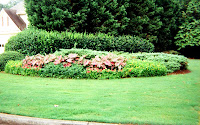Building a deck, and wondering what is the best size? Crabapple LandscapExperts suggests planning ahead and consider how it will be used, the number of people that will be sharing the deck, and the size of the existing grill and patio furniture. Is the deck going to be used for entertaining or is it only an entryway? Will cooking and dining be done on the deck, or primarily relaxing?
1. Install a deck that is in proportion with the house. Too large a deck can dwarf the home, while a deck that is too small feels crowded. And although no one wants the biggest deck in the subdivision, no one wants the smallest either. "I wish I had a smaller deck," said no one, ever. The typical 10' x 10' builders deck is useless.
As a rule of thumb, start with 16' x 16' as a minimum size. An average deck size is between 300 and 400 square feet.
2. Generally, a deck should be wider (dimension along the house) than it is deep (dimension sticking out from the house).
3. Larger decks can be multi-level in order to designate areas for different activities such as relaxing, dining, conversation.
4. Decks can be rounded or a geometric shape like an octagon or triangular.
5. Consider the entry points and number of steps needed. A deck should be 2 inches below the floor of the house.
6. Deck hand rails are an important design element. Consider the view through the railings and plan accordingly.
Ask your Crabapple Rep for some advice when building a deck in order to get the right size for your home and needs.










